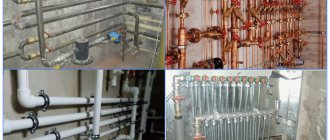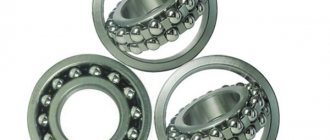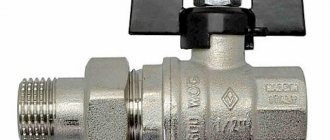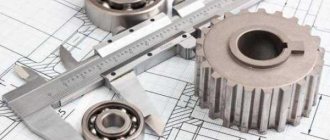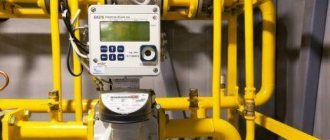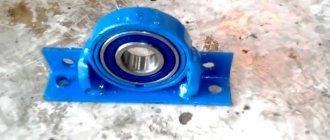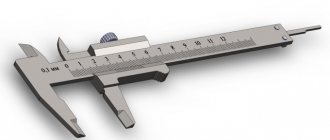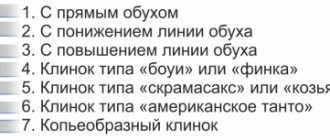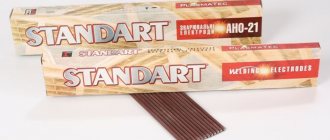How to determine its main dimensions and type based on the bearing markings?
In accordance with the accepted system of symbols for bearings, the numbers in the markings are counted from right to left.
The first and second numbers (on the right!) indicate the diameter of the shaft at the landing site (inner diameter of the bearing). Internal diameters from 10 to 20 mm are designated as follows:
| Nominal hole diameter, mm | 10 | 12 | 15 | 17 |
| Symbol | 00 | 01 | 02 | 03 |
| Example | 200 | 201 | 202 | 6203 |
For bearings with an internal diameter of 20 mm and larger (up to 495 mm), the same first and second digits show the quotient of the diameter size divided by 5. For example, the two rightmost digits 04 mean that the internal diameter of the bearing is 20 mm; numbers 25 correspond to a diameter of 125 mm, etc. The third and seventh numbers indicate the series of bearings by diameter and width, respectively. The fourth indicates the type of bearing: radial ball single row - 0; radial ball double-row spherical - 1; radial with short cylindrical rollers - 2; radial roller double-row spherical - 3; roller with long rollers or needles - 4; roller with twisted rollers - 5; angular contact ball - 6; roller conical - 7; thrust ball - 8; thrust roller - 9.
These are, of course, only the most general designations. It is simply impossible to present everything in a short answer.
Series
bearing is one of the normal rows established by the standards, differing from each other in the diameter of the outer surface and width with the same design and bore diameter. The type of bearing determines its basic properties: the direction of rotation and the shape of the rolling elements.
The variety of types and shapes of support nodes makes it difficult to choose a specific one. You can select a bearing by size from the table online. It's actually not that difficult to decide. To do this, you need to carry out a simple procedure for measuring an existing part that needs to be replaced or use already known parameters. If you follow the rules, you can select a specific model and order its purchase without leaving your home. Let us consider in detail how to do this so as not to make mistakes when purchasing new spare parts.
Measurement order
Now let's talk about how a caliper works. Before you start using it, you need to prepare the device and the part being measured: clean the surface of dirt to ensure maximum accuracy. The jaws need to be brought together tightly and the size of the gap between them needs to be assessed. If the design is working properly, then it will be minimal.
Next, the movable frame must be moved so that its first mark coincides exactly with the zero mark on the rod scale. If this is not taken into account and implemented, the results will not be accurate. If you cannot match these marks, then the caliper is faulty and is not recommended to be used. Only after making sure that the structure is completely prepared can you begin to work.
Measuring external surfaces
When it is necessary to measure a linear dimension or outer diameter, the sequence of using the tool is as follows. First of all, the sponges need to be spread apart by moving the frame. And then press them tightly against the opposite surfaces of the part that needs to be measured, and secure the position of the frame with a screw. If the outer diameter of a cylindrical part is measured, then its axis must be exactly perpendicular to the plane of the frame. If the length of a part or product is measured, then its longitudinal axis should be located exactly parallel to the rod. These conditions must be observed when using a caliper, otherwise it is impossible to obtain accurate results.
How to choose online bearings by size
There are many online services that provide the opportunity to select a part based on various parameters. Most often, 3 main quantities are used for searching:
- • inner diameter;
- • width (or height);
- • external diameter.
It is important to enter numerical data correctly. First of all, the internal hole of the support assembly is measured, then its external dimensions and only after that the width of the part.
Based on the search results, not one, but several supports with the same parameters and analogues for each of them can be returned. Some services even give an approximate cost for a particular type of part. All that remains is to choose the most suitable one in terms of price and availability.
Forms
Sometimes you can select based on other parameters: a specific name or type. So, you can easily find several analogues if you cannot purchase an original nodal support.
Even knowing all the parameters and observing the correctness of entering data into the search form, it can be difficult to settle on a specific choice. In this case, the staff will provide assistance. They will help you choose the most suitable option based on the characteristics of the machine in which the product will be used.
How to choose the right size online
You have to measure the main values of the reference unit yourself, and at this stage you can make several mistakes if you don’t know some tricks.
How to select a bearing according to the inner diameter of the shaft - d
Most questions are associated with its definition, since many types of products have a specific shape. When measuring, you must remember:
- • When selecting an element with a tapered hole, the internal diameter is measured along the smallest side.
- • Thrust bearings use a tension ring to determine the size.
- • If the part is accompanied by a sleeve, then it is inside it that the measurement is taken.
- • If the shape of the internal hole is different from circular, the calculation is carried out along the inscribed circle.
Sometimes the support unit is made without a ring at all. Then the diameter is measured not on the product itself, but on the working shaft. Knowing such little things, it will be much easier to find the bearing number by size online.
Calculation of external diameter - D
Regarding this parameter, everything seems much easier and in most cases, it is so. There are only two nuances. The first concerns the missing outer race ring. If your part has this feature, you can measure the value using the seat.
The second concerns technical characteristics. The outer diameter is classified into spherical and bombed type. The latter is found only in support roller ones and is associated with their complex profile. Unlike the internal diameter, the external diameter can have two values at once: standard and a parameter measured along the locking part.
Width calculation - B
When measuring this part of the part, it is necessary to take into account several nuances that relate to a specific type of product. For example, in a thrust-conical assembly, the ends of the cage may not be the same. In this case, the width is the difference in the dimensions of the two rings. It is important to take measurements in parallel. If difficulties still arise, it is better to seek advice from a specialist.
Violation of installation rules
Another reason can be identified as improper pressing. This reason is secondary. For example, during the repair process, a new bearing can be pressed in incorrectly, say, obliquely. For this reason, after just a few thousand kilometers the new wheel bearing begins to hum, and the car owner must replace it again.
Another reason that can be attributed to improper installation is over-tightening. In most cases, this happens on domestic cars. During the replacement process, the unit was overtightened, as a result of which it overheated, which did not have the best effect on the service life, and then broke. When installing, do not forget about the tightening force.
Selection of bearings according to parameters
The technical characteristics of the products are not limited to the listed values. The choice is influenced by many other data:
- • The maximum magnitude of the load by its nature and direction. Some parts can only handle radial and axial pressure, while others can handle mixed loads successfully.
- • Number of maintained revolutions per minute. The best performance here is characteristic of nodal rolling bearings.
- • Accuracy class, on which the rotation of the device, and hence the overall operation of the structure, depends.
- • Type of lubricant used (liquid, gas, etc.).
- • The moment of fatigue, that is, the maximum service life of the product.
- • Noise and vibration levels.
- • The actual dimensions, which have already been discussed earlier.
It is also important to take into account the operating conditions of the bearing, including temperature conditions, the ability to use it in water and other features. It can be difficult for the average person to decide on a specific type of support, and the selection form on the Internet is very limited and does not take into account most of the listed parameters. So it can be difficult to do without additional consultation from specialists, especially if the product is purchased to operate an expensive machine.
Purpose
There are 3 widely used types: sliding, rolling and magnetic. They differ in their design and scope of use. The first group consists of a body with a hole, a bushing and a lubricating device. To operate such a product, a large amount of lubricant is required, so a technician is required to regulate its supply. Today, this type of parts is used less and less, but they can be found in any equipment that requires high-speed operation, in steam and turbine installations, in navigation systems and many other high-precision devices.
Rolling bearings are by far the most commonly used. Basically, bodies are made in the form of balls and rollers. The main difference between these products and the first type is that there is no need to constantly lubricate the structure. The element can be used for a long time without this material, which means constant supervision by a specialist is not required. The variety of rolling bearings allows them to be used literally everywhere: from electric motors to household appliances, from complex industrial machines to medical equipment.
Magnetic devices are a structure that operates on levitation. It may include the product itself, an electronic system for monitoring its operation, or permanent magnets. The scope of application of such parts is very wide and unusual compared to others. They are often used in complex gas centrifuges, cryogenic technology, turbomolecular pumps and other mechanisms.
It is the specific type of bearings that becomes the basis of choice, since these parts are not interchangeable, although they can protect each other.
Vernier caliper design
Understanding the design features of this device is necessary in order to understand how to use it correctly. The caliper consists of the following parts.
- Fixed bar or ruler (bar). It represents the basis of the structure. There is a scale on it.
- A movable bar that can move along the bar. This bar has a vernier scale. It allows you to get very accurate measurements, namely, it counts fractions of a millimeter.
- Upper and lower lips. These are moving parts that allow you to measure an object and find out the dimensions both outside and inside. When the jaws are perfectly aligned, the zero marks on both scales should exactly match.
- Locking or clamping screw. It is required to fix the bar.
- Depth gauge. A thin retractable bar that can be used to measure depth. Electronic measuring devices are also equipped with batteries and a mobile mechanism.
In addition, there are models in the upper part of which there is a movable inch measuring scale. They are easy and convenient to use.
Classification according to various criteria
All types of nodal supports are classified according to different features, and some of them even according to several. What is common is the division according to the type of perceived load. According to it, all devices, regardless of whether they provide rolling or sliding, can be divided into:
- • Radial – remove a perpendicular load directly from the axis of the part.
- • Thrust – take the load from the shaft axis.
- • Thrust-radial or radial-thrust – combine the properties of the first and second.
The strength of the perceived load can also vary, so it is not enough to select a bearing based on its type; the maximum force must also be taken into account.
Another general indicator for classification is dimensions. According to them, all supports are divided into series. Each combines information about diameters and widths. Each device can be assigned a number from 0 to 9, with non-standard sizes designated 6, 7 or 8.
And finally, the most important indicator for classification is design features. Here the variety is very wide and is indicated in the markings by two-digit values from 00 to 99. For example, rolling bearings are divided into ball and roller bearings according to the shape of the body. The first are further divided into:
- • Cylindrical.
- • Conical.
- • Needle-shaped.
- • Spherical.
This variety allows you to increase the perceived load, noise and vibration levels, wear resistance, rotation speed and so on. Ultimately, all bearings are individually marked, taking into account the features of the device. It specifies the diameter, dimensions, type, design differences and some additional signs for complex parts.
The search for a new nodal support should begin by studying the instructions for the old one. All parameters must be specified in it. If such information is not available, selection is made by size. Then, taking into account the operating conditions and the specific characteristics of the machine into which the support is inserted, other basic indicators are selected. Assistance in choosing when purchasing will be provided by specialists who have extensive experience and understand all the intricacies of the process.
Reading results
It is not difficult to read the results obtained using a caliper. On the fixed frame (bar), where the main scale is located, determine the integer number (mm). The vernier scale shows hundredths of a millimeter. You need to find a stroke on the vernier scale on the caliper you are using that matches a certain number on the main scale. This indicator will be the value of the part size in millimeters.
Vernier scale
It happens that when measuring, a whole indicator is sufficient. If you want to set the value more accurately, you need to inspect the vernier scale. And on it you need to find the point of coincidence of the two marks. The number on the vernier scale will indicate the tenth value. By adding it to an integer, the user will receive the exact value of the part size.
By hourly indicator
When using a dial caliper, the whole number in millimeters can also be seen on the main scale. As on an analog device, it is determined by the coincidence of marks on both scales. The number presented on the dial shows a value from 0.01 to 0.99 mm, this depends on the value of the scale division. A pointer or dial caliper is a more accurate device than a mechanical (analog) one. It should be used when it is necessary to obtain perfectly accurate data.
By digital display
High-precision (up to hundredths of millimeters) readings of the results obtained when working with a digital caliper are presented on the liquid crystal display of the scoreboard. It is necessary to remember that it has different modes that show measurement results in both millimeters and inches. Such devices are also equipped with a vernier scale. It can be used if, for example, the battery runs out.
Benefits of bearings
Each type of support unit has its own unique advantages and disadvantages. But there are also common advantages, which is why their exploitation is so widespread.
Firstly, the operating time of the machine increases, since small parts take on an impressive part of the load. Accordingly, wear occurs later, and repairs are required much less frequently. Secondly, with the help of these products it is easy to increase the accuracy of certain parts of the structure. Thirdly, servicing the mechanism requires less effort, time and money. And finally, they are able to expand the functionality of the equipment in which they are built.
Rolling
There are a number of unique features that distinguish this type of device from another common type - sliding. Here are the main advantages:
- • Supports with rolling elements show a low coefficient of friction, which means they demonstrate better performance with minimal physical costs.
- • You can purchase this type of parts ready-made and install them into the mechanism yourself.
- • Products always comply with the standard, so they are very widespread, which means they can be easily found in the store.
- • The cost of this type compares favorably with others due to its wide distribution and mass production at leading factories that comply with GOST.
- • They operate successfully over a wide range of loads and speeds, making them easier to operate and maintain.
These support units still have some disadvantages. They are associated with reduced rotation accuracy compared to others.
Slip
The prevalence of this type of parts is decreasing every year, but in some conditions it is simply impossible to use rolling bearings. Main advantages of the type:
- • The rotation speed at which devices can operate is much higher than when using the first option.
- • They can easily withstand strong shock and vibration loads, which makes it possible to operate in difficult conditions.
- • With the same power, products can work in different environments, including water.
- • Split sliding elements are used on large crankshafts, and the amount of clearance can be adjusted.
Such features allow the use of nodal supports in high-speed mechanisms.
Types of calipers
There are three main types of such devices. Their use for a certain type of work is determined by its characteristics.
- Vernier or analog calipers. Measurements are made on a vernier scale. These power tools are simple and inexpensive. They are the most common.
- Dial or pointer calipers. To measure, instead of a scale, they have a dial that shows the results and does not require calculations. Their cost is higher than analog models. They are easy to use.
- Digital or electronic calipers. These are devices that have liquid crystal digital displays with rechargeable batteries. The use of such devices allows you to obtain the most accurate results. They show data in both millimeters and inches.
In addition to those listed, there are also models of special-purpose calipers. They are used for special jobs. For example, ШЦЦП, which measures parts with protrusions, or ШЦЦП - a design for measuring the tread pattern of tires, etc. These devices are not sold in regular stores; if necessary, they can be purchased on special websites. They are used by professional craftsmen.
All types of calipers have their own designations depending on the specific application.
- Vernier caliperSHTs-1. They measure parts, their external and internal dimensions using two pairs of sponges. It can also be used when measuring the size of a hole using a depth gauge.
- ShTs-1S. Such devices are equipped with arrow heads, making the measurement process simplified.
- Shtsk. Designs with a dial scale with a spring mechanism. It can be used for measurements when perfect accuracy is not required.
- SCT-I. Devices equipped with carbide-coated jaws to prevent surface abrasion. They are resistant to wear and can be used for a long time.
- SHTs-II. In addition to the jaws, such devices also have a mechanism for feeding the frame. Thanks to this, markings can be applied.
- SHTs-III. This device is large in size. The jaws on it are one-sided. Not suitable for depth measurement.
- SCC. A device with a digital scale from which readings are taken.
Each type of caliper is manufactured in accordance with the currently valid GOST 166-89 and is marked accordingly.
GOST 166-89 Calipers. Specifications
Pros and cons of using
The design features of parts directly affect their useful properties and disadvantages. Let's look at them separately.
Rolling
Among the undoubted advantages of this type of device are:
- • Low cost. This factor is especially relevant given that in some complex mechanisms up to several hundred support units can be used simultaneously.
- • Low friction does not lead to serious losses and strong heating. And in general, the supports behave equally well both at the start of operation and in an already established stable operating mode.
- • A wide variety does not exclude the interchangeability of parts, and easy installation allows you to make repairs quickly and efficiently.
- • For normal operation, virtually no lubricants are needed.
- • Overall, much less care and attention is required to the parts in which these products are installed.
On the downside, rolling devices are quite susceptible to shock and vibration loads due to their rigid design. This precludes their use in some machines. In terms of their dimensions, the products that provide rocking are large, and the work takes place in quite a lot of noise.
Slip
Among the advantages of use are:
- • Small size.
- • The design can be either detachable or prefabricated.
- • Performance in high-speed mechanisms is significantly better than that of other devices.
- • They are resistant to shock waves and vibrations, which increases the possibility of operation.
- • Works in the most adverse environmental conditions.
Among the disadvantages are:
- • The need for constant monitoring of the lubricant level, since without it the technical characteristics deteriorate significantly.
- • During start-up, large losses occur.
- • Efficiency is lower than in rolling bearings.
- • Expensive raw materials are used for production, which increases the overall price.
- • Components are produced unevenly, which complicates the maintenance of the entire machine as a whole.
You can search for a bearing by size online, but many other key parameters will still have to be determined additionally. With the right choice, you can ensure stable operation of the machine and reduce the need for maintenance. Sometimes it is better to seek help from professionals who will answer your questions and advise which option to choose.
A wide range of assemblies are found in stores and factories. Each of them is designed for its own task, meets a number of requirements, and is also suitable in size for the specified spare parts. In the article we will give a breakdown of the symbols and bearing numbers.
Brief information about multi-row installation
Such a decision is made in order to increase the load-bearing capacity of the unit and reduce the load on a single product. This is extremely important in high-speed supports.
The main condition for long-term and reliable operation is the uniform distribution of the load on each element of the bearing assembly. For products designed to withstand axial loads, this issue is quite simply resolved by ensuring the required manufacturing accuracy of the seating surfaces of the existing races, and the use of bearings with housings of equal rigidity (optionally, elastic).
It is more difficult to evenly distribute axial loads. The slightest errors made during installation, or an incorrectly sized bearing can lead to the fact that only the outermost bearing will take this load, while the rest either fall out completely or take it in small amounts. The issue is resolved by using preload.
As a rule, such a block uses two to four bearings having the same values of D and d.
Bearing sizing options
There are several options for solving this issue, the main ones are:
- Determination of sizes using known markings;
- Measurement of the product to be replaced.
As a rule, only the main bearing dimensions are determined. This:
- Inner diameter, designated by the letter “d”;
- Outer (“D”);
- Bearing width (“B”). For stubborn types, it is often called height and marked with the letter “H”.
Let's consider the first option in relation to a domestically produced bearing.
The bearing number can be found:
- According to the markings applied to the end surface of the holder;
- According to the product passport, existing certificate, or according to the shipping documentation. In addition, the type of bearing is indicated on its original packaging.
Decoding is carried out in accordance with current regulatory documents (for domestic bearings, this is GOST 3189-89).
The two right digits indicate the d value (up to 20 mm inclusive). With a diameter of 20
For imported bearings, it is necessary to follow other standards (taking into account the brand of the product).
At the same time, you should definitely remember that domestic and international markings differ, which can lead to a significant error when determining sizes.
A number of foreign manufacturers label their products according to the company’s internal rules.
Basic digital markings and diagram
The main thing you need to find out from the seller is which country manufactured the products. The fact is that the accepted norms and standards of Russian and foreign manufacturers differ. For the former, a domestic quality mark is prescribed - GOST 3189-89. It is always observed, this is strictly monitored by supervisory services, since failure to comply with production requirements threatens not only a discrepancy between the order (and it may be a state order) and the final result, but also emergency situations in production.
This part is one of the very important components in virtually every device where mechanical rotational movements are important. Significant damage is usually associated with its deformation. Therefore, you can be sure that when you buy bearings with numbering, you can completely rely on it.
First, we will consider domestic products, since they are more accessible and quite reliable, therefore they are used more often. They look something like this:
Y – XXXXXX – Z
Any number has three components:
- Core (X). Located in the center, it represents a database with basic data about the part. Expressed only in numbers. Six characters represent five indicators. There are hyphens on both sides.
- Prefix (Y). From the name it is clear that this is a preposition, that is, there is an identification mark at the very beginning. Can combine various sign systems. Expresses three interrelated meanings.
- Suffix (Z). Completes the combination and contains a lot of information. Consists mainly of letters of the Cyrillic alphabet (according to Russian GOST), but can be specified with numbers.
Here is a diagram with a breakdown of the markings of rolling bearings (its core)
Х(5) ХХ(4) Х(3) 0Х(2) Х(1)
where by numbers we mean:
- hole diameter - about this in more detail below;
- series size, that is, dimensions - multiplied coordinates and their values;
- node type - from 0 to 9, but the entire list below will be presented in the form of a table, because without it it is difficult to remember this classification;
- product design - a lot of codes are given for this category, up to 99 pieces, we will not list them in detail, but we will point out that the full list is in the document GOST 3395-89;
- dimensional category - the very initial number is responsible for a series of widths or heights, highly depends on the radii and cannot always be entered, especially when this indicator is non-standard.
The main difficulties arise when we talk about the size of the inner ring. What if it is larger than 9 mm? After all, only one figure is allocated for this indicator. But what if, on the contrary, the radius is so small that multiplied by 2 it does not even reach the minimum unit to fill the indicated cell of the number? Let's look at it below.
Additional designations
There are two categories:
- prefix;
- suffix.
Let's start with the console. It is located in front of the digital code and is compiled according to the rules:
- recording starts on the right;
- missing positions are discarded, and if there is absolutely nothing to write in the addition, then there is no need for dashes separating parts of the encoding.
Let's look at the components from right to left:
- Accuracy class. The highest abbreviations include “5”, “4”, “T” and “2”. A little worse – “0”, “6”, “6X”, the rest show that the indicator is very bad. Then the product can be considered low quality. This happens when the ratio of all elements is not precisely adjusted. Since bearings are marked after they are manufactured, if an error is found, a bad prefix is indicated.
- Radial clearance. Classified on a scale from 0 to 9, measured in tenths of a millimeter and shows the distance between the balls, that is, between the rolling elements. Median values are considered optimal. The normal indicator may not appear in any way in the recording.
- Friction moment series. The main, frequently used group includes 1, 4 and 7. The rest must be verified according to the document RD VNIPP.021-01.
- Category A, B or C. The latter is standard, it has no special requirements, so it is often not even indicated. But if you are dealing with A or B, then there will be digital values next to them indicating the class.
On the right, in the suffix, there is optional but important information about additional instructions. It is usually needed by those who deal with non-standard models. Indicated in Cyrillic letters. The request can be made in a whole system of standardized lists: GOSTs 5721, 24696, 24850 and 7872.
